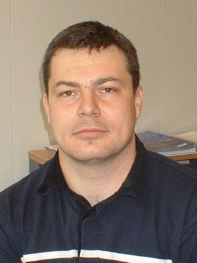Mems generated and AFM based surface modification
Promotion Date: 4 March 2006
CUM LAUDE
| Mems are micro electronic mechanical systems used in applications such as sensing and actuation. |
What was your thesis about?
Mems are micro electronic mechanical systems used in applications such as sensing and actuation. I started my PhD to detect the cause of wear on mems; a significant research for the fabrication of these micro electronic systems in data recorders, where even a small bit of wear can cause malfunction.
So this is a very practical research.
Yes.
What did you do?
There are two different subjects in the thesis, really. Basically I started with designing mems for research purposes (with surfaces of 5 square micrometer) that continuously rubbed against each other. When everything performed as we expected we did generate wear but could not detect it with optical systems. So I turned to AFM (Atomic Force Microscopy). But there it is very difficult to scan a surface with a small needle having a radius of only 20-30 nanometers to detect anything on such a comparatively big surface. Then I developed the idea for a new technique, the so called in situ wear detection with AFM, in which rubbing is performed with one tip, and the detection of the surface modification with another one at the same time. The two tips are mechanically connected, but they are differently loaded. That is a completely new technique. Then we also introduced a fluidic aspect to detect the influence of lubrication. The fluid leads directly to the tip, lubricating the surface while you scan. It turned out that this system had a much wider interest range than just tribology (research of wear and friction).
In a very controlled manner you can ‘write’ a layer on a surface, which is called fountain pen nano lithography. We are the first ones who presented a functional device.
Some other groups had been working towards it, but we proved the principle.
What are the possible applications?
You can fabricate nanosensors, biological sensors by functionalizing a surface with the fountain pen, or you could write nano electrical circuits.
Didn’t the success of the fountain pen nano lithography completely overshadow your mems design as a friction and wear tester?
I abandoned that idea from a tribology point of view, yes. But in the process of making these mems, we found innovative technology for the fabrication of actuators and also new ways to make structures. So for research purposes also that part of my PhD has been successful.
Was the conclusion also interesting for industry?
Parts of the results may be taken over by industry. But I am no longer involved in the mems designing part of things and did not follow everything that happens in the field.
You promoted cum laude, do you know for what part?
No, but the development of fountain pen nano lithography might have been a reason. Micro and nanotechnology develop extremely fast, thus it was just a matter of time who comes first with a functional device. More groups had been working on it.
Did it lead to publications?
Yes, we had a publication in Applied Physics Letters in 2004.
What did you like best about your research?
I cannot make a separation, I liked the Mems work and the AFM work equally well. I was lucky to be able to work in this group, they are supportive even if you come up with an idea that sounds like a long shot.
Was there something that you did not like?
No, I was happy to do my PhD here.
Where are you from?
I am from Romania. I was working in Romania as assistant professor, doing research on helicopters. We used new technology to reduce noise and vibration on helicopter blades. For that purpose I went to an advanced summer school in Italy in 2000 where professors from all over the world were giving lectures for a week. I was impressed especially by the talks of Professor Elwenspoek, and discovered the new world of micro. I wanted to join that world.
I applied and after an interview I got a position.
What was the interview like?
It is a heavy day, starting at 9.00 hrs and finishing about 17.00 hours, talking to different people and giving a lecture on your past work for the group. But luckily it did pay off.
What are you going to do next?
I would like to stay in research. I would also like to stay in the Netherlands. I enjoyed Enschede very much, also because of all the sports facilities. I enjoy all sports, the physical challenge of sports is a good counterbalance for all the brainwork.
Last question: did you know that you were getting a special distinction for your PhD work?
No, it was a complete and utter surprise, but of course a very pleasant one. I felt very proud, but would like to add that without the support of the group I could not have done it.

